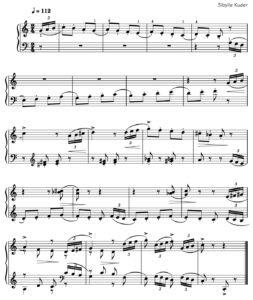The purpose of this etude is to work on a healthy technique for using the fourth finger.
Found throughout this short piece is a recurring four-note scale fragment, always played quickly with fingers 1-2-3-4, to work on drop-and-lift gestures.
There is no need to “strengthen” the fourth finger, or subject the student to so-called “isolation” exercises, but it is necessary to understand how a healthy technique is needed to play effortlessly and effectively: the wrist needs to gradually, over the course of the four notes, move up and forward, and a bit out – aligning the arm behind the fourth finger. Students who struggle with fourth finger issues usually do so because they attempt to pull the key down, and their wrist is too low. The fourth finger then tends to bend in the last joint, and there is much unnecessary tension inside the hand and in the wrist, resulting in discomfort and uneven tone. No amount of finger exercises will improve fourth finger issues unless they are practiced with a healthy technique.
This teaching piece has no dynamic markings which does not mean that dynamics are not important. Rather, it is intentionally left up to the teacher to determine what kind of dynamics a student would benefit from: earlier level students may do better with fewer dynamic marks which stay between mezzo piano and mezzo forte and which perhaps change only once or twice throughout the piece whereas a more experienced student could handle more frequent, and subtle and/or gradual dynamic changes. The teacher may also consider whether it would be useful to add somewhat extreme dynamics – only piano throughout the entire piece, or a very strong forte throughout – depending on whether a student would benefit from this additional challenge.
Because of the frequent use of patterns, this etude can easily be taught by rote which allows for the focus to be on technique which is to be understood as the study of motion.
Further reading:
http://benjaminsteinhardt.com/but-my-fourth-finger-is-weak-the-myth-of-finger-independence
.

